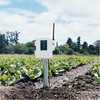Turfgrass quality is visually evaluated by human assessors based on a scale of 1(the grass is dead) to 9 (the grass if of outstanding quality) in the current assessment method. This evaluation practice has several disadvantages and therefore, there is the need for a better evaluation technique. Individual biases are inevitable and lead to some level of inconsistency, even among the most highly trained observers.
The Field Scout TCM 500 “NDVI” Turf Color Meter measures reflected light from turf grass in the red (660 nm) and near infrared (850 nm -NIR) spectral bands. Research from Clemson University, Predicting Visual Quality Ratings of Turfgrass Research Plots Using Spectral Reflectance (Roy B. Dodd, ASAE etal.) is the basis for the technology used in this meter. NDVI denotes Normalized Difference Vegetative Index.
Since chlorophyll absorbs the red band (660 nm) of incoming radiation, the reflectance is relatively low due to the strong
absorption of the light by the
plant pigments. The high reflectance in the NIR (850 nm) band is caused by the cellular structure of the plant leaves particularly the spongy mesophyll leaf structure.
• Red & NIR values are presented in three modes: as an index (0 to 99) of Red/NIR in %, NDVI, and Grass Index (ie. 7.3).
Download the manual.

